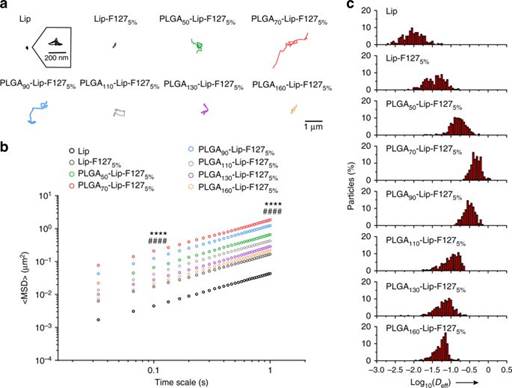研究人员发现纳米药物载体递送力学机制
来源:《自然通讯》
作者:甘勇等
时间:2018-07-26

中科院上海药物所甘勇课题组与国家纳米科学中心施兴华团队合作,深入解析了纳米药物载体的力学性能对于克服多重生理屏障的影响。相关成果日前在线发表于《自然通讯》(Nature Communications)杂志。
纳米药物载体在到达靶细胞之前,须克服生物体内的多重生理屏障。为实现疗效最大化,设计和制备能克服多重生理屏障并具备高效细胞摄取的递送载体,成为纳米药物从实验室转向临床应用的一个重要挑战。
据了解,甘勇和施兴华前期发现,棒状粒子特有的“旋转—跳跃”运动方式能促进其在黏液中的扩散,并提出了一个考虑颗粒黏附效应的障碍—扩散理论模型。同时,双方又发现制约纳米载体口服递药和肿瘤递药的共性生理因素:具有网状结构的生物凝胶(如黏液和肿瘤细胞间质)在药物载体抵达靶细胞前扮演了重要的阻滞作用。
在最新研究中,研究人员采用微流控技术,设计制备了刚度可调的纳米药物载体,发现刚度适中的载体在生物凝胶中具有最高的扩散系数,拥有最优的细胞摄取量和药物递送能力。(来源:中国科学报 黄辛)
Rapid transport of deformation-tuned nanoparticles across biological hydrogels and cellular barriers
Abstract To optimally penetrate biological hydrogels such as mucus and the tumor interstitial matrix, nanoparticles (NPs) require physicochemical properties that would typically preclude cellular uptake, resulting in inefficient drug delivery. Here, we demonstrate that (poly(lactic-co-glycolic acid) (PLGA) core)-(lipid shell) NPs with moderate rigidity display enhanced diffusivity through mucus compared with some synthetic mucus penetration particles (MPPs), achieving a mucosal and tumor penetrating capability superior to that of both their soft and hard counterparts. Orally administered semi-elastic NPs efficiently overcome multiple intestinal barriers, and result in increased bioavailability of doxorubicin (Dox) (up to 8 fold) compared to Dox solution. Molecular dynamics simulations and super-resolution microscopy reveal that the semi-elastic NPs deform into ellipsoids, which enables rotation-facilitated penetration. In contrast, rigid NPs cannot deform, and overly soft NPs are impeded by interactions with the hydrogel network. Modifying particle rigidity may improve the efficacy of NP-based drugs, and can be applicable to other barriers.
原文链接:https://www.nature.com/articles/s41467-018-05061-3.pdf




